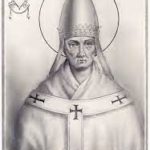
Pope St. Mark reigned as the bishop of Rome and head of the Western Church from January 18, 336 A.D. through October 7, 336 A.D. after the papacy of Sylvester I. In his under a year long pontificate, St. Mark has been credited for having awarded the rights to consecrate all new popes to the bishops of Ostia.
He is widely regarded as the founder of two churches in and near Rome in the presently-existing Church of St. Mark (San Marco) in Rome and a basilica built atop the Balbina catacomb along the Via Ardeatina.
Brief History and Background on Pope St. Mark
Obscure Early Life and Career of Pope St. Mark
History has not remembered much of the life of Pope St. Mark. The Liber Pontificalis states that Mark was born a Roman to a father named Priscus. On January 18, 336 A.D., Pope Mark succeeded his predecessor Pope Sylvester I. Thanks to the notation of Mark’s election to the papacy in the Liberian Catalogue of Popes it is considered to be certain historically.
The Acts and Accomplishments of the Pontificate of Pope St. Mark
Historical evidence exists suggesting that the Catholic Church’s early listings of martyrs and bishops called the Depositio martyrum and the Depositio episcoporum were started under the papacy of St. Mark. The Liber Pontificalis notes that the pope issued an act that gave the privilege of consecrating all new popes to the Bishops of Ostia. This same act also invested Ostia’s bishops with a pallium.
The same Liber Pontificalis gives Pope St. Mark the credit for founding the still in use Basilica of San Marco found in Rome as well as the cemetery church that sits atop the ancient Catacomb of Balbina. This second church lies just beyond the Roman city limits and is found on lands that Emperor Constantine donated to the pope and church in between the Via Ardeatina and the Via Appia.
Today’s San Marco basilica was altered externally after the time of Pope St. Mark. In the 400’s A.D. the church was mentioned as a Roman title church giving certainty to Pope Mark having founded it.
The Legacy and Death of Pope St. Mark
The Arian controversy was raging in the Eastern Church during the time of Pope St. Mark, yet no historical record indicates that Pope Mark was involved in attempting to resolve it. While there has been some debate concerning whether or not Pope Mark actually invested the Bishops of Ostia with the rights to consecrate all elected popes St. Augustine of Hippo (author of The City of God) witnessed the rights of the Ostia bishops to bestow this consecration at the end of the 300’s A.D. in his vast and mostly preserved writings.
The day of Pope Mark’s death is certain on October 7th when so many other historical facts from this ancient time are lost to history. The reason is that his death was noted in Philocalus’s “Chronography” in the “Depositio episcoporum” whose first edition was published in 336 A.D.
List of events in the life of Pope St. Mark
| Date | Event | Title |
|---|---|---|
| 18 Jan 336 | Elected | Pope (Roma, Italy) |
| 7 Oct 336 | Died | Pope (Roma, Italy) |
Pope St. Mark Quick Facts
– Born – exact year unknown, in Rome, Italy
– Birth Name – Marcus
– Died – October 7, 336 A.D., in Rome, Italy
– How he died
Pope St. Mark perished from natural circumstances on October 7, 336 A.D. The church originally buried him in the Balbina catacomb. Just over 700 years later in 1048 A.D. the church moved his remains into a town called Velletri. His final resting place saw his remains placed in an urn beneath the altar in the Basilica of St. Mark (San Marco) in Rome where the church moved him in year 1145 A.D.
– Papacy began – January 18, 336 A.D.
– Papacy ended – October 7, 336 A.D.
– Successor – Pope Julius I
Interesting Facts About Pope St. Mark
Pope Mark received bequests of land and liturgical furniture from Roman Emperor Constantine the Great for the two basilicas St. Mark built.
A letter that is allegedly written by Pope St. Mark to St. Athanasius turned out to be a forgery done later.
Pope Mark was originally laid to rest in the catacomb of Balbina in Rome.
The church celebrates Mark’s feast day on October 7th.
Pope Mark’s remains became relocated to the Italian town of Velletri in 1048 A.D., and were moved once more in 1145 A.D. to the Rome-based Basilica of San Marco (St. Mark) that the pope founded.
Pope St. Mark is especially venerated today in Monte Amiata in the Abbadia San Salvatore.